by Matthew Orwat | Apr 8, 2014
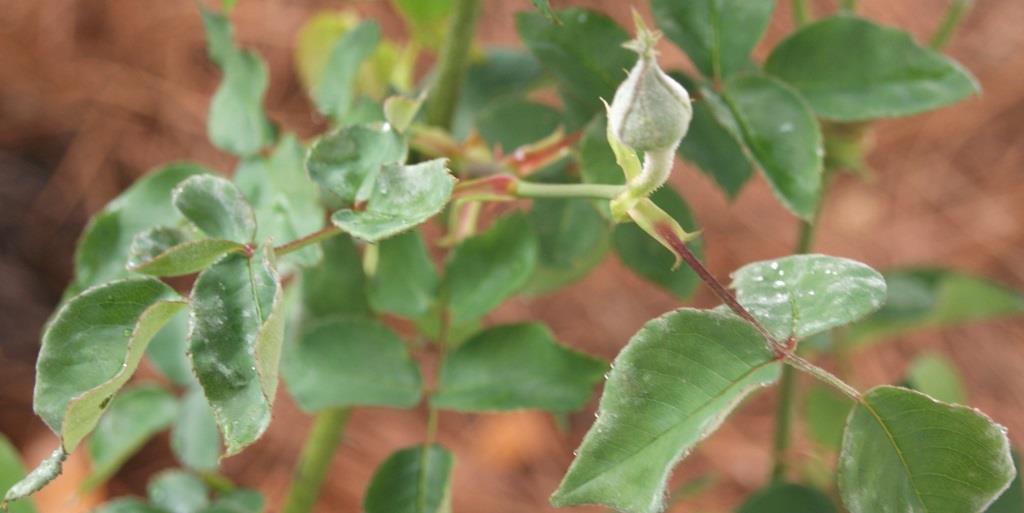
Powdery mildew on rose bud. Image Credit Matthew Orwat.
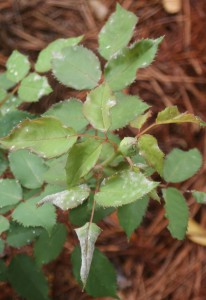
Powdery mildew on rose leaf. Image Credit Matthew Orwat.
This spring powdery mildew has been prevalent on many non-resistant cultivars of ornamental plants, particularly rose and crapemyrtle.
Ideal conditions for powdery mildew development, warm days and cool nights followed by rain, have been present for several weeks in Northwest Florida.
This fungus, which looks like powdered sugar and is caused by several different species, appears on new growth and causes distorted and stunted leaf and flower development. It grows in thin layers on the surface of leaves and reproduces by spores.
Mild cases are of little concern, as most plants will grow out of it once environmental conditions change to be less favorable for development of the pathogen. Severe cases can cause distorted growth, leaf drop and flower destruction.
In these cases, fungicide application will protect new growth from this disease. Some lower toxicity fungicides that have been shown to have effectiveness on powdery mildew include neem oil and potassium bicarbonate (otherwise known as Baking Soda).
Sulfur can be used, but cannot be applied when temperatures reach above 90 ° F. Other chemical fungicides, including those containing myclobutanil, or azoxystrobin can be used but products obtained must be labeled for ornamental use. Remember, the label is the law.
Many disease resistant cultivars of rose and crapemyrtle exist, please follow the links provided for more information.
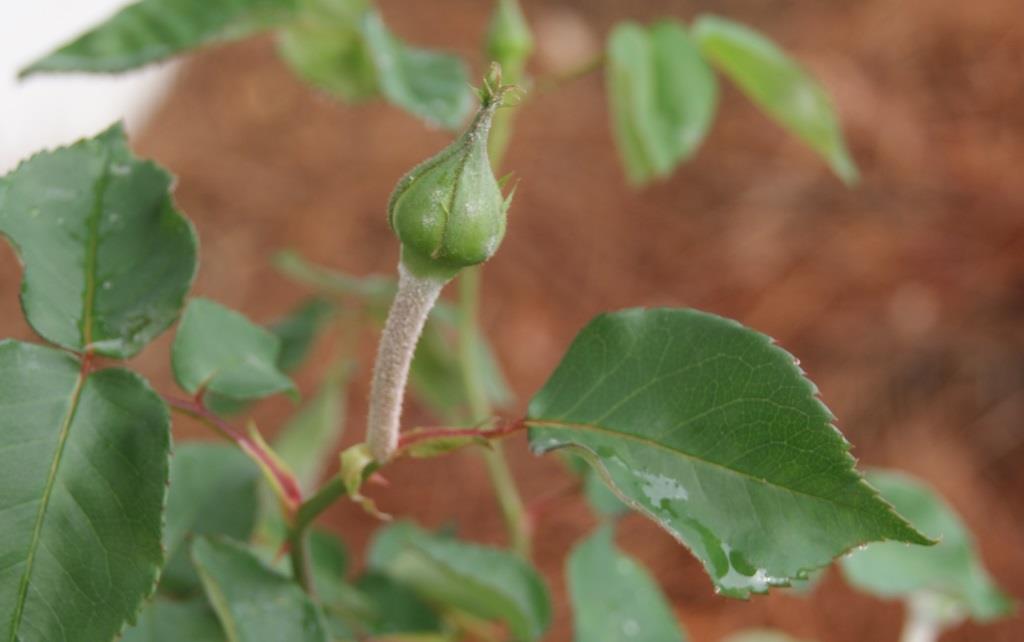
Powdery mildew on rose petiole. Image Credit Matthew Orwat.

Powdery mildew on rose. Image Credit Matthew Orwat.
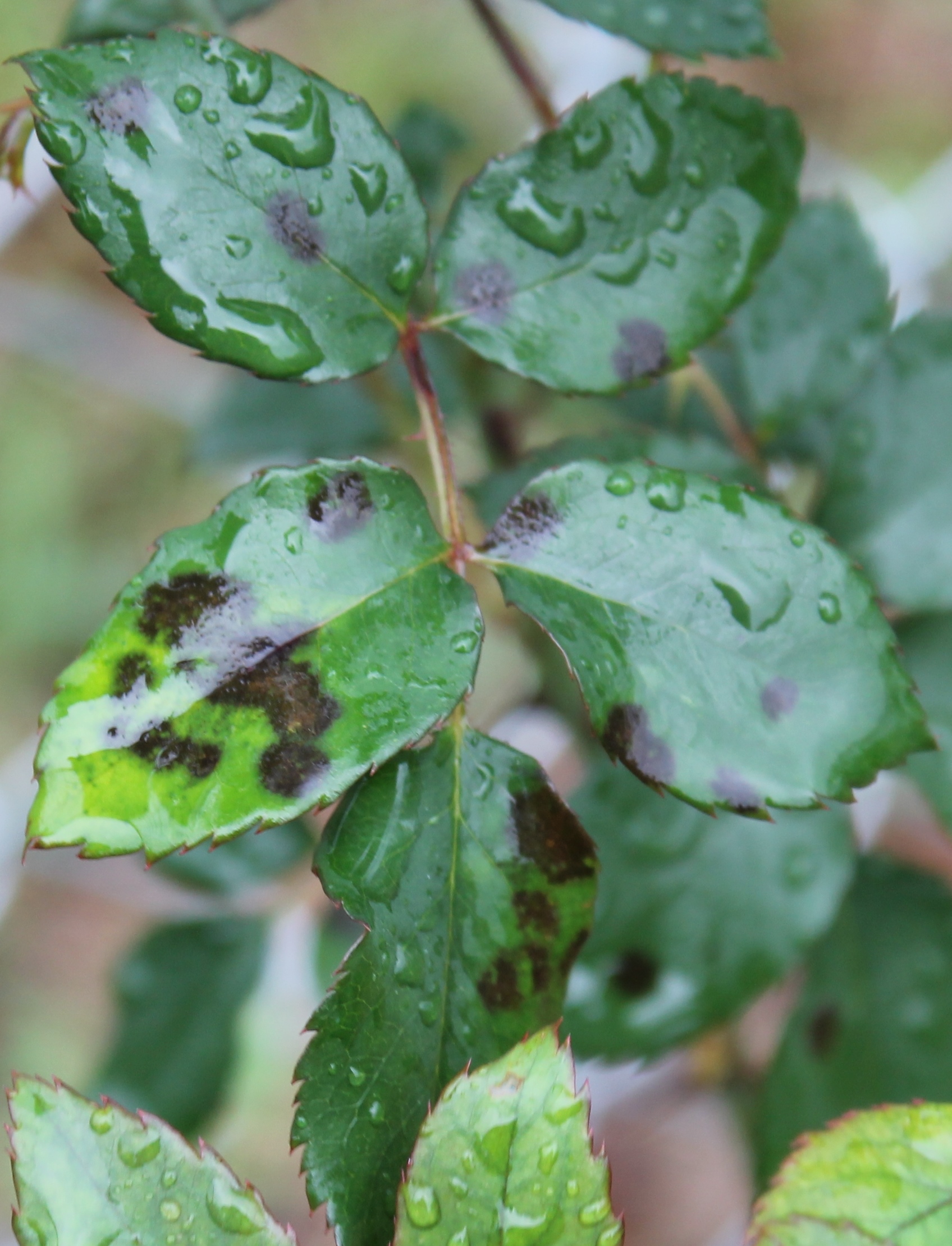
by Matthew Orwat | Mar 18, 2014
March may seem a little early to worry about fungal diseases, but recent prolonged wet weather and warmer temperatures have made the climate just right for a variety of leaf diseases in the Florida Panhandle. One in particular, Blackspot (Diplocarpon rosae), is particularly problematic for the discerning rose grower. Blackspot is just beginning to be seen this season on non-resistant rose cultivars throughout the central Florida panhandle.
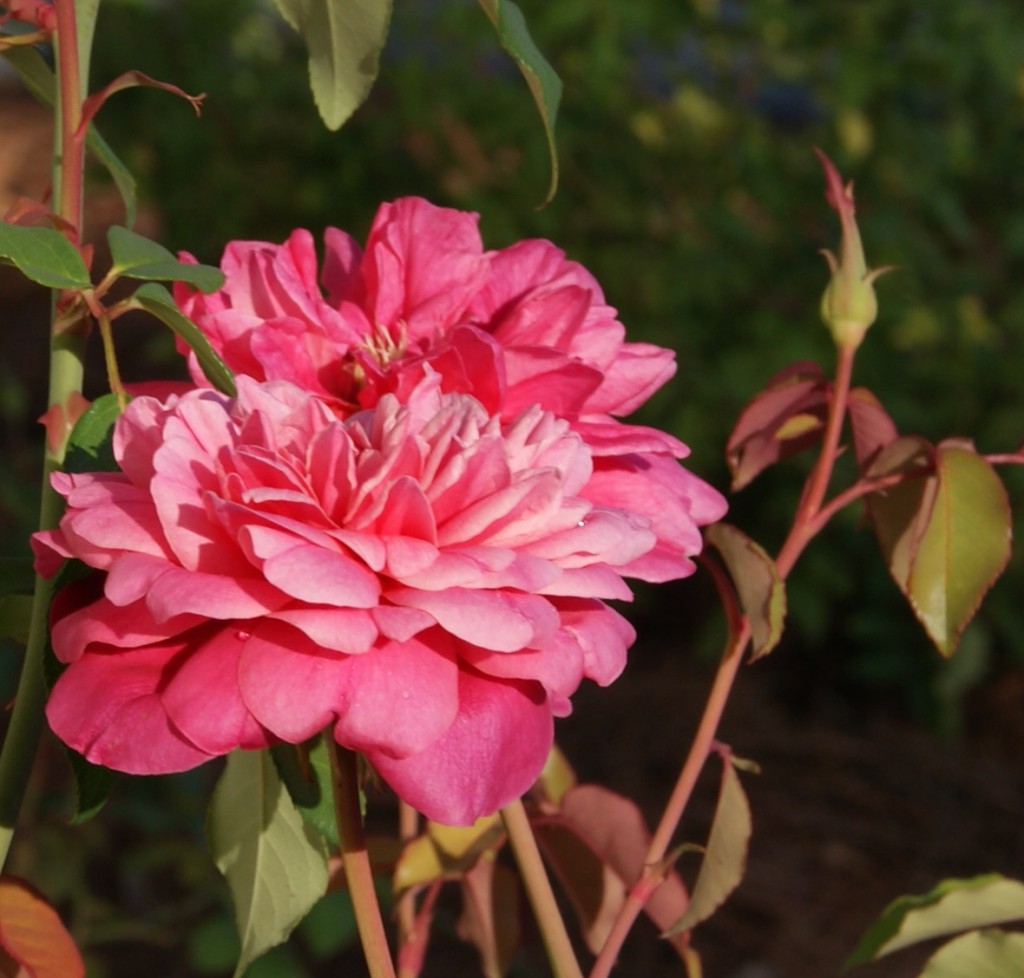
Monsieur Tillier, a rose that shows promise for blackspot resistance, is also part of the Earthkind program. Image Credit Matthew Orwat
Blackspot spores are spread from the canes or leaves of the previous season’s growth by rain or overhead irrigation. To minimize innoculum (black spot spores) remove all leaves from the previous season and any dead leaves at the base of the plant. After the annual pruning in mid to late February, it is a good idea to spray roses with sulfur or copper based fungicidal soap. This helps kill spores that have been laying dormant throughout the winter. Be careful not to spray these products when temperatures rise above 80 ° F. Doing so could burn the plants, although these products will damage tender young growth as well at temperatures below 80 ° F .
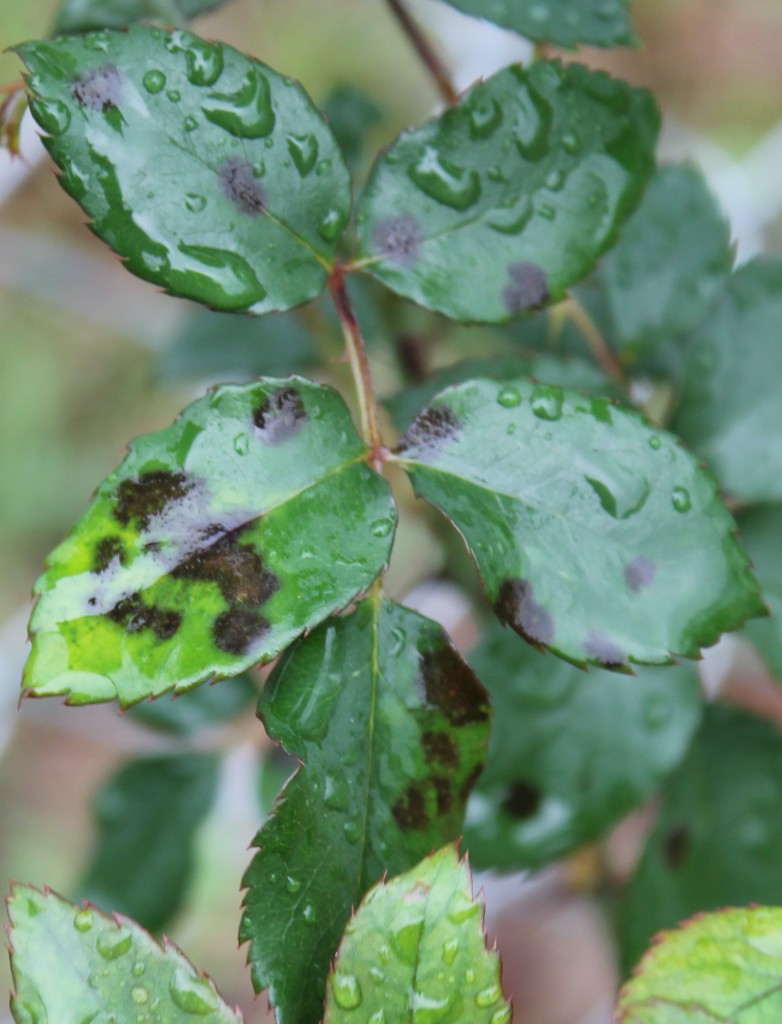
Wet, blackspot affected leaves. Image Credit Matthew Orwat
While dormant sprays often allow rose gardeners to get ahead of the disease, the best defense for the home garden is to plant resistant cultivars. There are several old and new resistant cultivars on the market. Some new resistant cultivars of note include Home Run and Knockout. Also, several older cultivars have demonstrated excellent resistance, such as Mrs. B.R. Cant and Spice. The author has been working with several older rose cultivars at the UF / IFAS Washington County Extension demonstration garden that have shown resistance during the last three years. While this demonstration garden is not a scientific study, several roses that have demonstrated some merit include Belinda’s Dream, Monsieur Tillier, Mme. Antoine Mari, Rosette Delizy and Souvenier de la Malmaison. Another resource for information on disease resistant roses is the Texas Earthkind rose program from Texas A&M University. While disease resistance is not always identical in different parts of the county, their recommended list gives the beginning rose gardener a good place to start.
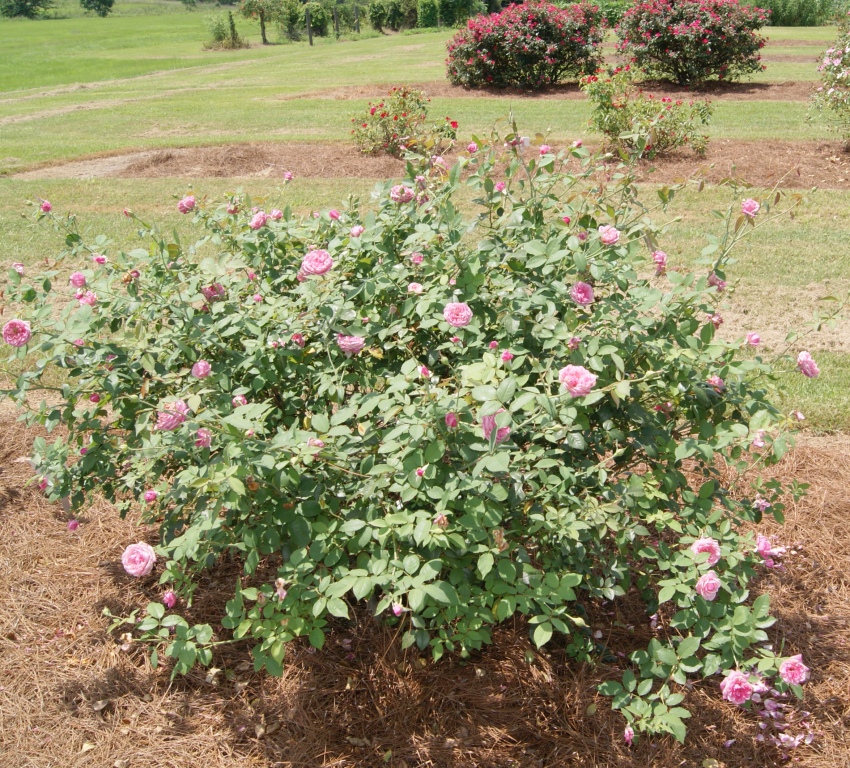
Mrs. B. R. Cant, a tea rose from 1901 has shown very good blackspot resistance at the UF IFAS rose trials in Quincy, FL. Image Credit Matthew Orwat
Several other cultural methods that will prevent spread of this disease among the rose garden include avoiding overhead irrigation, planting in well ventilated areas and proper plant spacing. These techniques attempt to make the garden environment inhospitable for blackspot proliferation.
Regardless if these management techniques are followed, if traditional large, long-stemmed, high maintenance Hybrid Tea roses are desired, most Florida rose gardeners will need to begin a spray schedule to prevent the onslaught of blackspot. Several fungicides are on the market to aid in this process, but remember that they must be used regularly (every 7-14 days) and modes of action must be rotated. This means that different types of fungicide must be rotated so that resistance to a particular fungicide by the blackspot organism does not develop. Below is a table of recommended fungicides for homeowner blackspot control. For more information, please consult the UF IFAS Extension publication P268, Blackspot of Rose.
Fungicide products marketed toward homeowners for control of black spot on roses
|
Active ingredient
|
Fungicide group
|
Trade name
|
|
Copper hydroxide
|
M1
|
Hi-Yield ® Copper |
|
Copper Sulfate
|
M1
|
Bonide® Copper Dust |
|
Copper Octanoate
|
M1
|
Bonide® Liquid Copper, Natural Guard Copper Soap, Ortho® Disease B Gon® Copper Fungicide |
|
Sulfur
|
M2
|
Bonide® Sulfur Dust, Ferti-lome® Dusting Sulfur, Green Light, Hi-Yield® Dusting Wettable Sulphur, Ortho® Bug-B-Gon® Rose & Flower Care |
|
Mancozeb
|
M3
|
Bonide® Mancozeb |
|
Captan
|
M4
|
Bonide® Captan 50WP, Hi-Yield® Captan 50W Fungicide |
|
Chlorothalonil
|
M5
|
Bonide® Fungonil, Ferti-lome® Broad Spectrum, Hi-Yield® Vegetable, Flower, Fruit and Ornamental Fungicide, Monterey, Ortho® Disease B Gon™ Garden Fungicide , Monterey Fruit Tree, Vegetable & Ornamental Fungicide |
|
Myclobutanil
|
3
|
Spectracide Immunox® Multi-Purpose Fungicide |
|
Propiconazole
|
3
|
Ferti-lome® Liquid Systemic Fungicide, Monterey Fungi-Fighter |
|
Tebuconazole
|
3
|
Bayer Advanced™ Disease Control for Roses, Flowers & Shrubs |
|
Tebuconazole + Imidacloprid
|
3 +
|
Bonide® Rose RX Systemic Drench, Feti-lome® 2-N-1 Systemic |
|
Triforine
|
3
|
Ortho® RosePride® Disease Control |
|
Calcium Polysulfide
|
NC
|
Hi-Yield® Lime Sulfur Spray |
|
Neem Oil
|
NC
|
Bonide® RX 3 in 1, Green Light® Neem Concentrate, Green Light® Rose Defense®, Monterey |
|
Acetamiprid + Triticonazole
|
NC + 3
|
Ortho® Bug B Gon® Insect & Disease Control |
|
Acephate + Resmethrin + Triforine
|
NC + NC + 3
|
Ortho® RosePride® Insect, Disease & Mite Control |
| Fungicide Group (FRAC Code): Numbers (1-37) and letters (M) are used to distinguish the fungicidal mode of action groups. All fungicides within the same group (with same number or letter) indicate same active ingredient or similar mode of action. This information must be considered in making decisions about how to manage fungicide resistance. M=Multi-site inhibitors, fungicide resistance is low; NC= not classified. Source: http://www.frac.info/ (Fungicide Resistance Action Committee, FRAC).
Always read a current product label before applying any chemicals.
|
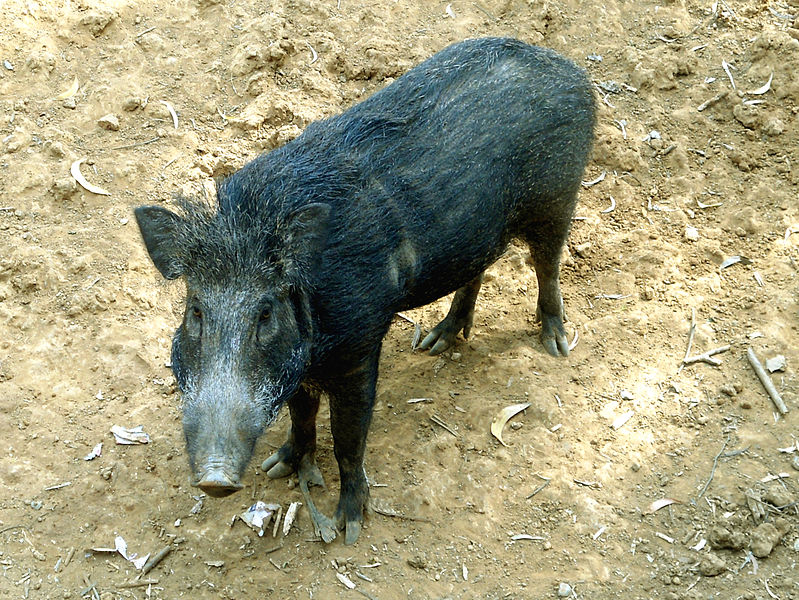
by Carrie Stevenson | Mar 18, 2014
The first week of March every year is designated “National Invasive Species Awareness Week,” an initiative to draw attention to the thousands of invasive plants and animals that move into our state and country every year. However, this is a problem that should draw focus year-round.
Invasive species are non-native or exotic plants and animals which can cause harm to the local economy, human health, and the environment. They often out-compete native species, causing habitat degradation, wildlife community imbalances, and diseases that can destroy economically important plants. This is a worldwide issue that can be addressed on local levels. In Florida, researchers have documented over 1,180 exotic plant species and more than 500 non-native fish.
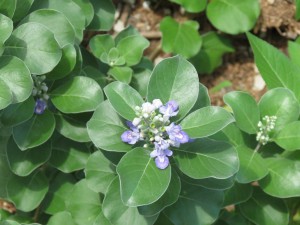
Beach vitex is a newly introduced invasive found on our local barrier island due systems. Photo credit: Rick O’Connor
Prevention is among the most effective ways to manage invasive species. Gardeners should be aware of invasive species and make sure they are not unintentionally passing them on to neighbors or natural areas. While many non-native plant species perform well in our yards and do not become invasive, pay close attention to new plants that start taking over your yard. If you’re unsure of the status of a plant, call your local Extension Office or check the Florida invasive plant list.
When enjoying outdoor activities such as camping, hiking, or biking, be sure to inspect what might have attached to your clothing to prevent further seed dispersion.
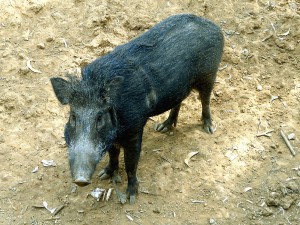
Wild hogs cause significant damage to ecosystems throughout Florida.
Released pets are a nearly impossible problem to manage, as well. If you have a pet that you can no longer keep, please find an alternative home for it. Releasing pets into the wild can have serious implications for native wildlife and cause harm to your animal. One needs look no further than the python problem in the Florida Everglades to see the extent of damage this unwise practice can cause. Great information on what to do with unwanted pets can be found at Habitattitude.
Among the most important invasive plants to be aware of in our area include: cogongrass, Chinese tallow (popcorn trees), coral ardisia, water hyacinth, Japanese climbing fern, Chinese privet, tropical soda apple, torpedo grass, and beach vitex. Among invasive animal species in the area, be on the lookout for: lionfish, crazy ants, feral hogs, and Cuban treefrogs.
There are many ways to get involved in the battle against invasive species, including joining your local Cooperative Invasive Species Management Area (CISMA) group. Special thanks to Brooke Saari (bsaari@ufl.edu) for contributing to this article.
by Les Harrison | Mar 4, 2014
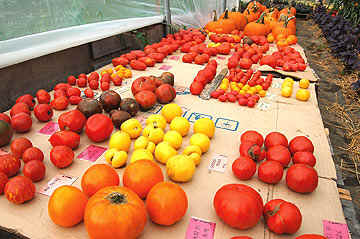
An assortment of Heirloom Tomatoes. Image Credit Dan Culbert
Thursday night’s temperatures have confirmed the winter of 2014 is not over. This year’s cold days and freezing nights have taken a toll on power bills, auto batteries, and the mosquitoes.
Still there is indication that spring will soon be coming. The most tangible evidence is arriving in north Florida mailboxes almost daily.
Garden catalogs from every part of the nation are finding their way into many area homes. Their pages promise the buyer the potential for legendary success and the envy of their friends and neighbors.
After all, who can resist the full color beauty of giant flowers, large luscious fruit and vegetables which are sure to win a prize at the fair? There is not a runt, reject or cull in all the pages of these publications offering the mortal version of horticultural heaven.
Before ordering, the would-be gardener should consider several factors to increase the likelihood of a positive gardening experience. A failure will waste not only funds, but also much time and hard work and may introduce a long-term problem or two.
Cultivar selection for a tree, shrub, vegetable or fruit is critically important to producing the desired results. While a specific plant cultivar may grow and produce in one environment, it may not do so in all situations.
A common example of this problem is grape vines offered. Only muscadine grapes will grow and produce locally because Pierce’s disease kills other varieties.
Carefully examine the growing zones recommended by the catalog for specific cultivars. Check with fellow gardeners and the UF/IFAS Extension Office to see if they have any information or experience with any cultivars under consideration.
Heirloom varieties are especially sensitive to the variances in growing conditions. While they offer unusual and sometimes unique taste and culinary traits or landscaping characteristics, these antique varieties can be a challenge to grow.
Their genetic potential can make a consistent yield, especially for the novice growers, a real effort. Also, as an open pollinator variety, the results can be inconsistent.
Another question for the catalog company customer is new or untried plants varieties. Some of these plants are patented and few or no trials have been performed with them in north Florida’s growing zone.
Caution should be used when ordering these seed or plants. Being the first in North Florida to cultivate a new variety may require a large commitment of time and resources, and may produce only a large disappointment.
Check with fellow gardeners, local nurseries and your UF/IFAS Extension Office for available information on these new or patented varieties. It may save much wasted motion.
Lastly, be sure the plant or seeds under consideration do not have the potential as exotic invasive pests. As hard as this may be to believe, this does occur.
Some catalog vendors will advise buyers in the ordering instructions or at the time of ordering. Either way, the purchaser should check to verify the plant ordered does not have the potential to escape control and damage the environment.












